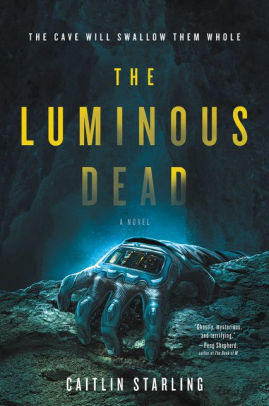The cover copy of The Luminous Dead, Caitlin Starling’s debut novel, makes it sound like a pretty piece of science fiction horror. The mines of Cassandra-V produce profitable minerals, but the planet itself is no garden world. Expeditions into the planet’s caves to find new mining sites are extremely dangerous. Aside from the usual hazards of caving (a dangerous occupation at the best of times), the caves are home to Tunnelers, a native species that’s drawn to heat and sound, and whose behaviour can change the topography of a cave system—also they’re deadly and nigh-unstoppable.
Gyre, an inexperienced (but competent) caver, has lied her way onto an expedition that’s offering a big payout—a payout big enough to get her off-planet. She thought she’d be working with a skilled surface team to monitor her suit and environment, and help keep her safe and sane in the dangerous, isolating dark. But instead, she’s got a single voice at the other end of her comms. This other woman, Em, withholds critical information and manipulates Gyre’s body with drugs—and she knows that Gyre lied about her experience. This setup looks, in a nutshell, like survival horror: Gyre striving to survive in an inimical environment and fighting to maintain her autonomy against a handler who should be on her side.
Fortunately for us, Starling has written a deeper, richer, and more complicated story. The Luminous Dead is a story of two isolated people who have been defined (and who have defined themselves) by traumatic losses in their childhoods as they open up to each other in the darkness of a cave whose depths may prove unsurvivable. From Gyre’s perspective (from any reasonable perspective), Em has done monstrous things in pursuit of a goal that seems quixotic. But Gyre can also understand, at least partly, what’s driven Em to these extremes. (It’s not as though Gyre hasn’t made some pretty extreme choices herself.) Em can make different choices, still.
As Gyre delves deeper into the caves, though, she has two different struggles to face. The first and most straightforward is with the demanding, treacherous physical environment of the caves. A wrong decision could see her injured and trapped, stranded without supplies, or hopelessly lost with no way of making it back to the surface—even if she doesn’t encounter a Tunneler. But the second struggle is with her own mind, and that may complicate the first. She’s torn between trusting Em to see her safely through and the creeping suspicion that keeping her alive doesn’t top Em’s list of priorities. As she delves deeper, little inconsistencies begin to prey on her mind: missing supplies, the bodies of dead cavers before her, the growing weight of Em’s secrets. She can’t shake the feeling she’s being followed. That she’s not alone in the dark. Is it paranoia born of her isolation and stress, or some kind of psychotropic reaction to contaminated water supplies, or is there actually someone else done there with her? If she’s going to make it out alive, she’s going to have to figure out which she trusts least: her handler, or her own mind.
Buy the Book


The Luminous Dead
Starling has written a tightly-focused novel, part psychological thriller, part deep character study. Starling keeps the reader closely focused on Gyre, whose viewpoint is the only one we see (and whose name recalls the line from W.B. Yeats’ “Slouching Towards Bethlehem”—turning and turning in the widening gyre/ the falcon cannot hear the falconer). We see Em through Gyre, and through her actions. The arc of their relationship is one that bends from antagonistic distrust and manipulation to intimacy and honesty, but the narrative never forgets that Gyre’s sympathy for Em may be more of a consequence of Gyre’s isolation and Em’s role as her one connection to the outside world as much as anything else.
The world of The Luminous Dead is the world of the cave. Starling depicts the terror and the wonder of the environment through which Gyre moves with deft strokes. She also emphasises its physicality. And the mental confusion and exhaustion that strikes Gyre when she feels at her weakest—though Starling’s a little less than perfectly adept at making Gyre’s paranoia and despair tensely compelling in isolation.
I should mention that Gyre is a queer woman, and that this is a novel with a queer relationship in it. Whether one views that relationship as potentially healthily romantic—well, I think that’s one of the questions The Luminous Dead is asking, about trust and growth and change.
This is a gripping debut from a talented voice, and I look forward to reading more of Starling’s work in the years to come.
The Luminous Dead is available from Harper Voyager.
Book cover © Harper Voyager; Background image by VasGian. Modified from original under CC BY-SA 3.0 license.
Liz Bourke is a cranky queer person who reads books. She holds a Ph.D in Classics from Trinity College, Dublin. Her first book, Sleeping With Monsters, a collection of reviews and criticism, was published in 2017 by Aqueduct Press. It was a finalist for the 2018 Locus Awards and was nominated for a 2018 Hugo Award in Best Related Work. Find her at her blog, where she’s been known to talk about even more books thanks to her Patreon supporters. Or find her at her Twitter. She supports the work of the Irish Refugee Council, the Transgender Equality Network Ireland, and the Abortion Rights Campaign.










